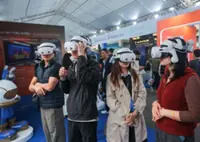FILE PHOTO: A self-driving GM Bolt EV is seen during a media event where Cruise, GM's autonomous car unit, showed off its self-driving cars in San Francisco, California, U.S. November 28, 2017. REUTERS/Elijah Nouvelage/File Photo
WASHINGTON/SAN FRANCISCO (Reuters) -A California regulatory judge on Tuesday grilled officials at General Motors' Cruise unit and law firm Quinn Emanuel over Cruise's delay in disclosing the details of a pedestrian crash involving one of its self-driving cars.
The comments were made at a hearing for Cruise's motion to resolve the investigation by the California Public Utilities Commission (CPUC) into the accident involving its robotaxi.
In December, the commission accused Cruise of misleading it "through omission" on the extent and seriousness of the accident and for "misleading public comments" on interactions with the agency.
On Oct. 2, a pedestrian hit by another vehicle was thrown into the path of a self-driving Cruise vehicle and dragged 20 feet. California suspended the testing permit, and Cruise halted all U.S. testing operations.
"I appreciate you are making some corrective actions but at the same time, I'm just sort of bothered when I look at the totality of facts," Administrative Law Judge Robert Mason said at the hearing.
A Cruise representative responded, "It was regrettable. It was a mistake. And Cruise is attempting to make right with the mistake."
In December, the CPUC said a Cruise official telephoned a commission analyst the day after the crash but "omitted that the Cruise AV had engaged in the pullover maneuver which resulted in the pedestrian being dragged an additional 20 feet at 7 mph."
Cruise offered $75,000 to resolve the investigation and also pledged to boost its reporting of collisions to the commission as part of its settlement offer, saying "the reckoning for Cruise in the aftermath of the Oct. 2 accident has been swift and extensive." The unit has fired nine executives over the October crash.
The company commissioned a report from law firm Quinn Emanuel that said Cruise did not intend to mislead. A separate technical review by engineering firm Exponent found the Cruise vehicle suffered from mapping errors and incorrectly identified hitting the woman as a side impact collision, the report stated. Cruise has since updated its software.
California suspended the company's driverless testing license, and Cruise pulled all its U.S. self-driving vehicles from testing. The unit's CEO Kyle Vogt and co-founder Dan Kan resigned in November.
In December, Cruise announced it was cutting 24% of its workforce. GM said last week it was cutting spending by about $1 billion at Cruise in 2024.
The same month, the National Highway Traffic Safety Administration opened an investigation into pedestrian risks at Cruise.
(Reporting by David Shepardson; Editing by David Gregorio)





